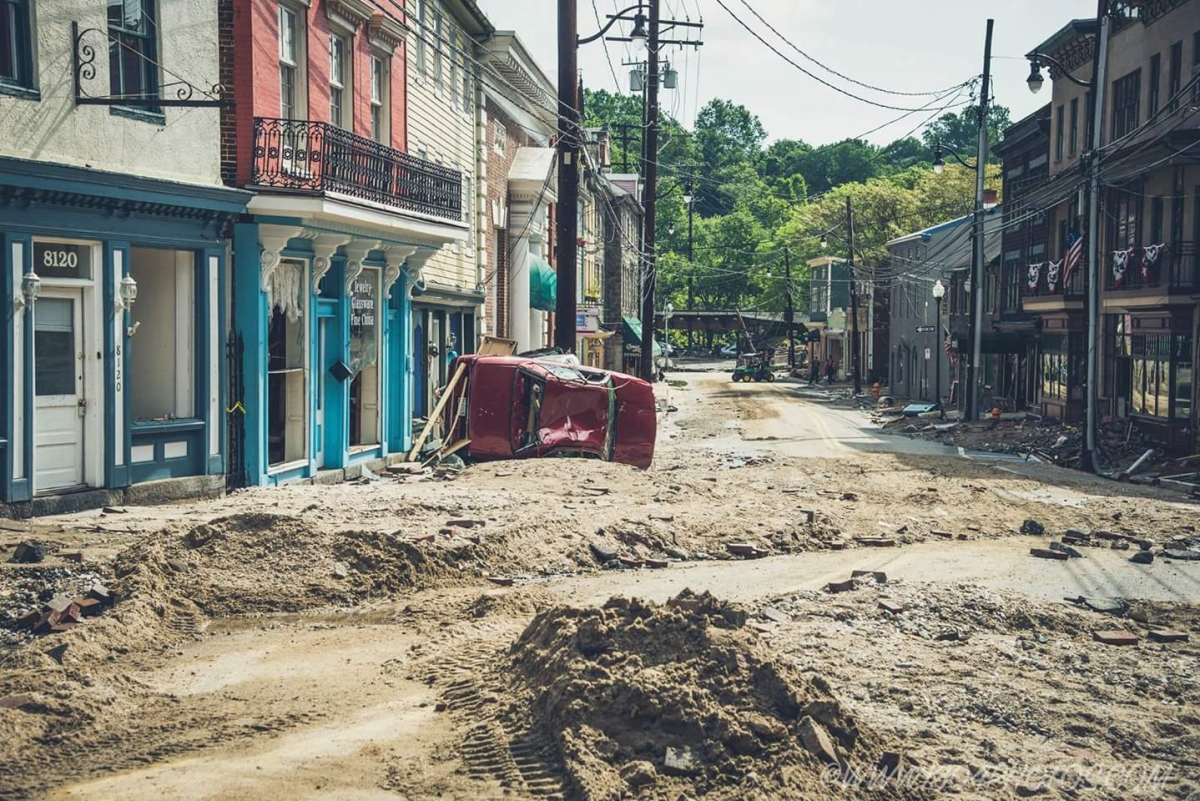Deadly floods – Maryland to China – have surprising connection to rising sea level

Last Saturday night when many had planned a nice evening out for dinner in quaint Ellicott City, a devastating flood occurred, largely destroying the downtown. Six inches of rain in just two hours caused the record water mark in that historic Maryland community.
Flash floods, monsoon rains, and rivers overflowing their banks are becoming common headlines. Ellicott City joins the rapidly growing list of deadly deluge that in the last month spans West Virginia, Texas, France, Germany and China. All of these inland floods resulted from extreme rainfall.
This surge of inland flooding would seem to be quite different than the coastal flooding resulting from storms, extreme tides, and rising sea level, yet surprisingly they share the same underlying cause.
Unusual flooding from extraordinary rains results from two things. First, the warming oceans mean more evaporation, putting more moisture in the atmosphere. That excess moisture has to come out as either rain or snow, depending on the local temperature.
The oceans keep warming following the increase in level of carbon dioxide and other greenhouse gases. Globally the sea temperature is roughly one and a half degrees Fahrenheit (almost one degree Celsius) warmer than a century ago.
As the oceans warm and the polar ice cap (around the north pole) melts, major air currents like the Jet Stream, change location. Recall the so-called polar vortex that brought excess snow to mid-Atlantic areas of the U.S. in recent years.
It is the combination of more moisture in the air, and the changing ocean and atmospheric currents that are causing these extreme rainfall events and flooding which defy good prediction. While weather forecasting has been getting much more accurate, the higher heat levels, the greater moisture and evaporation, and changing ocean and atmospheric currents challenge even the best models because we are in unfamiliar territory. The overall heat level of the oceans and atmosphere have not been this high for more than a hundred thousand years.
Higher sea level primarily results from the same warmer global temperature, causing the glaciers and ice sheets on land to melt. Though still only a modest rate, the melting is accelerating. From our measurements in Greenland and Antarctica we know that sea level rise will get worse throughout this century. In fact the last few years of record heat in the polar regions worries scientists that the collapse of the glaciers may be stepping up to a new level, which will in turn affect sea level all over the world. Thus extreme rainfalls and rising sea levels result from the same underlying cause or force: the warming sea.
This Ellicott City deluge has now been deemed a “once-in-a-thousand-year event” yet even that is very misleading. We do not really know that such a sudden downpour has not occurred in a millennium. Rather, the calculation is that the chance of this occurring this year was one in a thousand –a tenth of a percent. That is converted to the once-in-a-thousand-years term to help us understand the odds. But all such calculations are based on historic weather patterns and ocean heat levels, which are rapidly changing. In other words, we can’t predict the future precisely because the “Earth system” is already at unprecedented heat levels. Furthermore, we are struggling with the policy issues of how to make our energy, with fossil fuels or alternatives, which largely will determine how much heat we add to the system.
Perhaps most important is what we take away from these events like this week’s Ellicott City disaster. What do we do, moving forward. Many believe that we can solve the problem of global warming with the recent targets to limit global warming set in Paris. As I explained in a blog post at the time, those accords can greatly help to limit the future warming and the potential catastrophe, but unfortunately we have passed a tipping point in terms long-term weather patterns, better known as climate. https://johnenglander.net/paris-climate-agreement-the-good-the-bad-and-the-ugly
To learn the lessons of the record levels of inland and coastal flooding, we need to understand three related but separate concepts:
1. Weird weather will continue far into the future, breaking out of all the patterns that we have come to expect for generations. Wherever possible we should anticipate and design for extreme heat, temporary floods, as well as drought – with all the related effects of more fires, effects on agriculture, etc.
2. Sea level is special because it defines the shorelines – the land areas—not only on the coasts, but also through marshlands and up tidal rivers. Sea level rise is now unstoppable and will cause essentially permanent change worldwide. We can design for it and must start that process immediately. It is not an option. The rising sea does not care about laws, politics, or opinions. It is already rising and causing “nuisance flooding” with the regular peak tides in communities worldwide, but this is just the beginning.
3. We must reduce the level of warming, caused by the rising level of greenhouse gases ASAP. Carbon dioxide is a key factor. Historically the level of CO2 ranged from 180-280 parts per million (ppm). It is now over 400 ppm and rising steeply. We need to enact policies that reduce the emissions as a most urgent priority, yet recognize that it is not possible for that to stop the disastrous changes to weather patterns and rising sea level in the next few decades.
Unless we tame the “monster” of greenhouse gases, the warming will continue with catastrophic results. It traps the heat in the system, which ultimately causes the unusual amounts of ocean evaporation and rainfall, and also melts the glaciers and ice sheets, causing sea level to rise.
Earth is a complex system and most things are connected. It is important to grasp the connections so that we can change the right policies while preparing for the changing world that lies ahead.
